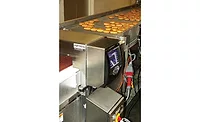Quality products demand sensitive,stable metal detection
When older metal detection systems can’t provide accurate results in an environment filled with vibration, it’s time to upgrade.

Newly Weds Foods (NWF) got its start in 1932 when NWF President Paul Angell combined sheet cake and ice cream to form the world’s first ice cream cake roll. Since then the company has opened new facilities around the world, developing and producing batters, breadings, seasoning systems, capsicums, liquids, functional ingredients, stuffing crumb and English muffins.
Since many of its incoming ingredients are dry, and many of its finished products are dry or use ingredients that may have been exposed to grinding or mixing, NWF uses metal detection technologies to keep end products free of metal fragments known as tramp metal. “Incoming ingredients are run through numerous magnets and rotary sifters before being delivered to the point-of-use,” says Angel Calvillo, project engineer. “All outgoing products are subject to screening through a metal detector before release. There are two X-ray systems being used in the company’s Horn Lake, MS facility to monitor packaging lines that cannot use metal detectors due to the type of foil used in the packaging,” he adds.
Metal detection systems have been in place for many years as a final checkpoint before product is transferred to the warehouse for distribution. As earlier generations of metal detectors age, their technology shows signs of age, too. “Older metal detection units do not have the sensitivity required in today’s marketplace,” says Calvillo. “Further, the units would sometimes reject accidentally due to equipment vibration. NWF required a unit that would be resistant to the vibration,” he adds.
When Calvillo began his career at NWF, the company extensively used metal detectors from Fortress Technology because of its good customer service and easily maintainable units that meet stringent standards. “NWF has installed Fortress flow-through and drop-through units as the last checkpoint on a line to assure no contamination of tramp metal,” says Calvillo.
“We have a number of Fortress Big Bag King belt conveyor units in our plants. Our products [batters, breaders and spices] are packaged and run through the metal detectors before being palletized,” says Calvillo. “We also have drop-through units on our stack-ups where conveyors are not used. They are at the closest possible discharge point [on a stack-up between a packaging hopper and a bagger].
“Adding a drop-through unit onto an existing stack-up can become a challenge when plagued by height limitations. Fortress representatives were available for discussion and provided alternative solutions to the problem,” adds Calvillo.
“I have a great deal of confidence in the Fortress units’ ability to detect tramp metal,” he says. “The sensitivity of the equipment and its consistency in delivering correct responses in an environment filled with vibration makes Fortress a good choice in meeting Newly Weds Foods’ metal detection needs.”
For more information:
Steve Mason, 416-754-2898, foodeng@fortresstechnology.com

To provide the highest-quality products, Newly Weds Foods uses Fortress Technology’s Phantom metal detectors in several areas of its plant to check for potential contamination of tramp metal before packaging and palletizing. Source: Fortress Technology Inc.
Newly Weds Foods (NWF) got its start in 1932 when NWF President Paul Angell combined sheet cake and ice cream to form the world’s first ice cream cake roll. Since then the company has opened new facilities around the world, developing and producing batters, breadings, seasoning systems, capsicums, liquids, functional ingredients, stuffing crumb and English muffins.
Since many of its incoming ingredients are dry, and many of its finished products are dry or use ingredients that may have been exposed to grinding or mixing, NWF uses metal detection technologies to keep end products free of metal fragments known as tramp metal. “Incoming ingredients are run through numerous magnets and rotary sifters before being delivered to the point-of-use,” says Angel Calvillo, project engineer. “All outgoing products are subject to screening through a metal detector before release. There are two X-ray systems being used in the company’s Horn Lake, MS facility to monitor packaging lines that cannot use metal detectors due to the type of foil used in the packaging,” he adds.
Metal detection systems have been in place for many years as a final checkpoint before product is transferred to the warehouse for distribution. As earlier generations of metal detectors age, their technology shows signs of age, too. “Older metal detection units do not have the sensitivity required in today’s marketplace,” says Calvillo. “Further, the units would sometimes reject accidentally due to equipment vibration. NWF required a unit that would be resistant to the vibration,” he adds.
When Calvillo began his career at NWF, the company extensively used metal detectors from Fortress Technology because of its good customer service and easily maintainable units that meet stringent standards. “NWF has installed Fortress flow-through and drop-through units as the last checkpoint on a line to assure no contamination of tramp metal,” says Calvillo.
“We have a number of Fortress Big Bag King belt conveyor units in our plants. Our products [batters, breaders and spices] are packaged and run through the metal detectors before being palletized,” says Calvillo. “We also have drop-through units on our stack-ups where conveyors are not used. They are at the closest possible discharge point [on a stack-up between a packaging hopper and a bagger].
“Adding a drop-through unit onto an existing stack-up can become a challenge when plagued by height limitations. Fortress representatives were available for discussion and provided alternative solutions to the problem,” adds Calvillo.
“I have a great deal of confidence in the Fortress units’ ability to detect tramp metal,” he says. “The sensitivity of the equipment and its consistency in delivering correct responses in an environment filled with vibration makes Fortress a good choice in meeting Newly Weds Foods’ metal detection needs.”
For more information:
Steve Mason, 416-754-2898, foodeng@fortresstechnology.com
Looking for a reprint of this article?
From high-res PDFs to custom plaques, order your copy today!





